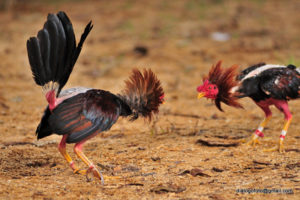 ERNEST HEMINGWAY APASIONADO POR LAS PELEAS DE GALLOS EN CUBA. HISTORIA.
ERNEST HEMINGWAY APASIONADO POR LAS PELEAS DE GALLOS EN CUBA. HISTORIA.
El novelista y periodista norteamericano Ernest Hemingway pasó buena parte de su vida en Cuba. Sus huellas se encuentran por toda La Habana. Completamente aplatanado, Papa Hemingway vivió su vida como un cubano más e hizo todo lo que acostumbraban los naturales de la Isla: tomarse sus traguitos en el bar local, salir a pescar al Golfo y, también criar sus gallos de pelea.
En 1949 escribió que “criar gallos de pelea, adiestrarlos y participar en las competencias” era una de las razones por las cuales se había decidido a vivir en Cuba. Fue un apasionado de las peleas de gallos y en su finca La Vigia mandó a construir una pequeña valla para que se efectuaran las competencias. En ese negocio se asoció con José Herrera, alias Pichilo, quien se mantuvo junto al norteamericano cuidando sus gallos hasta 1942.
Hemingway llegó a criar hasta 20 ejemplares al mismo tiempo para participar en las competencias. Lo hacía porque le daba placer, no por el afán de ganar dinero, pues en realidad nunca apostó mucho en esas lides.
Según sus propias palabras nunca le movió el afán de ganancia. Sólo le gustaba participar y cuando tenía la suerte de ganar se lo gastaba casi todo en la misma cantina de la valla, invitando a todos los presentes a festejar a cuenta suya.
LAS PELEAS DE GALLOS EN CUBA.
El primer documento oficial que se conoce acerca de las peleas de gallos en Cuba data del 8 de abril de 1737. Consiste en un Decreto Real solicitando al gobernador un informe sobre si las peleas de gallos podrían tener “inconvenientes con la gente del mar y la tierra” y donde se piden noticias acerca del arrendamiento del juego.
Este juego se hizo tan común en la época colonial, que en todos los poblados urbanos o rurales se construyeron “vallas”, denominación que se les da en Cuba a los ruedos creados para este fin. En La Habana, en el centro de la ciudad, entre el Castillo de la Fuerza y el edificio de la Intendencia, Don Francisco Dionisio Vives, entonces Capitán General de ls Isla, tenía una gallería para su diversión y la de sus amigos.
Cuando el Teniente General español Don Miguel Tacón y Rosique fuera nombrado por la Reina Isabel II de España con el título de Gobernador de la “Siempre fiel Isla de Cuba” en 1834, éste puso coto a las peleas de gallos y por una Circular fechada el 20 de octubre de 1835, se prohibió este tipo de eventos en las tabernas del campo y casas particulares, reduciéndose a las poblaciones en días festivos solamente.
Años después, Don Leopoldo O’Donnell, quien fue Capitán General de la isla, dictó el Decreto del 25 de julio de 1844 por el que se prohibían las lidias de gallos en poblados y la asistencia a las vallas de la gente de color e “hijos de familias”. El acceso a la gente de color se prohibía, porque en las vallas, con la pasión de la pelea se olvidaban las diferencias sociales, sin reconocer en aquel espectáculo ninguna línea que marcara las diferencias de casta. Además, estas actividades eran puntos de reunión para conspirar contra el gobierno español.
Durante casi toda la segunda mitad del siglo XIX se fueron concediendo autorizaciones para establecer vallas de gallos.
En 1899 el entonces Gobernador Civil de La Habana, el General Juan Rius Rivera, prohibió las peleas de gallos por el Decreto del 31 de octubre de 1899. Y el 19 de abril de 1900 el Gobernador de Cuba, el General Leonard Wood, a propuesta de su Secretario de Gobernación y Estado, el Dr. Diego Tamayo, emitió la Orden militar No.165 prohibiéndose desde el 1 de junio de 1900 en todo el territorio de la Isla.
En 1909, el entonces Presidente de la República de Cuba, José Miguel Gómez, para ganar simpatizantes autorizó nuevamente las peleas de gallos y se acordaron reglamentos para su ejecución.
De más está decir que siempre… en todas las épocas, se ha apostado dinero en Cuba a las peleas de gallos.
https://youtu.be/-_MzSqqwFcI
En la primera mitad del siglo XX la legalidad de las peleas de gallos en Cuba sufrió varios altibajos.
Hasta finales de 1967 y principios de 1968 se realizaban peleas en todo el país, pero en interés de eliminar las apuestas se cerraron las vallas y se prohibieron las peleas, aunque no así la crianza de los gallos.
En 1980 las autoridades despenalizaron las peleas eliminándolas como figuras delictivas y convirtiéndolas en simples contravenciones. De más está decir que siempre… en todas las épocas, se ha apostado dinero en Cuba a las peleas de gallos.
 ERNEST HEMINGWAY PASSIONATE FAN OF THE COCKFIGHTS IN CUBA. HISTORY.
ERNEST HEMINGWAY PASSIONATE FAN OF THE COCKFIGHTS IN CUBA. HISTORY.
American novelist and journalist Ernest Hemingway spent a good part of his life in Cuba. His prints are found throughout Havana. Completely flattened, Papa Hemingway lived his life as a Cuban and did everything the natives of the Island used to do: take his drinks at the local bar, go fishing in the Gulf and also raise his fighting cocks.
In 1949 he wrote that “raising fighting cocks, training them and participating in competitions” was one of the reasons why he had decided to live in Cuba. He was passionate about cockfighting and at his farm, La Vigia ordered a small fence to be built for competitions to take place. In that business he was associated with José Herrera, alias Pichilo, who stayed with the North American guarding their cocks until 1942.
Hemingway managed to raise up to 20 horses at the same time to participate in the competitions. He did it because it gave him pleasure, not because of the desire to make money, because he never really bet much on those issues.
According to his own words, he never moved the desire for profit. He only liked to participate and when he was lucky enough to win he spent almost everything in the same bar on the fence, inviting all those present to celebrate at his expense.
THE FIGHTING FIGHTS IN CUBA.
The first official document that is known about cockfighting in Cuba dates from April 8, 1737. It consists of a Royal Decree asking the governor for a report on whether cockfighting could have “problems with the people of the sea and the land “and where news about the lease of the game is requested.
This game became so common in the colonial era that “fences” were built in all the urban or rural towns, a name given in Cuba to the rings created for this purpose. In Havana, in the center of the city, between the Castillo de la Fuerza and the Intendencia building, Don Francisco Dionisio Vives, then Captain General of the Island, had a gallery for his amusement and that of his friends.
When the Spanish General Lieutenant Don Miguel Tacón y Rosique was appointed by Queen Isabel II of Spain with the title of Governor of the “Always Faithful Island of Cuba” in 1834, he put an end to the cockfights and by a circular dated October 20, 1835, this type of events was banned in the country taverns and private homes, being reduced to the populations on holidays only.
Years later, Don Leopoldo O’Donnell, who was Captain General of the island, dictated the Decree of July 25, 1844, which prohibited the fight of roosters in villages and the attendance at the fences of the people of color. children of families. ” Access to people of color was forbidden, because in the fences, with the passion of the fight, social differences were forgotten, without recognizing in that show any line that marked caste differences. In addition, these activities were meeting points to conspire against the Spanish government.
During most of the second half of the 19th century, authorizations were granted to establish billboards for roosters.
In 1899 the then Civil Governor of Havana, General Juan Rius Rivera, banned cockfighting by the Decree of October 31, 1899. And on April 19, 1900 the Governor of Cuba, General Leonard Wood, on proposal of his Secretary of the Interior and State, Dr. Diego Tamayo, issued Military Order No.165, which was banned from June 1, 1900, throughout the territory of the Island.
In 1909, the then President of the Republic of Cuba, José Miguel Gómez, to win supporters again authorized cockfights and regulations were agreed upon for their execution.
Needless to say, always … in every era, money has been waged in Cuba for cockfights.
In the first half of the twentieth century, the legality of cockfighting in Cuba suffered several ups and downs.
Until the end of 1967 and the beginning of 1968, fights were held all over the country, but in order to eliminate bets, the fences were closed and fights were prohibited, although not the raising of the roosters.
In 1980 the authorities decriminalized the fights eliminating them as criminal figures and turning them into simple contraventions. Needless to say, always … in every era, money has been waged in Cuba for cockfights.
Agencies/ TodoCuba/ Maikel Mederos/ Internet Photos/ Arnoldo Varona/ www.TheCubanHistory.com
THE CUBAN HISTORY, HOLLYWOOD.



 ERNEST HEMINGWAY Passionate Fan of the Cockfights in Cuba. History.
ERNEST HEMINGWAY Passionate Fan of the Cockfights in Cuba. History.





